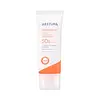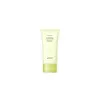What's inside
What's inside
 Key Ingredients
Key Ingredients

 Benefits
Benefits

 Concerns
Concerns

 Ingredients Side-by-side
Ingredients Side-by-side

Water
Skin ConditioningBis-Ethylhexyloxyphenol Methoxyphenyl Triazine
Skin ConditioningDibutyl Adipate
EmollientDiethylhexyl Succinate
EmollientEthylhexyl Triazone
UV AbsorberDiethylamino Hydroxybenzoyl Hexyl Benzoate
UV FilterPropanediol
SolventPolysilicone-15
UV FilterNiacinamide
Smoothing1,2-Hexanediol
Skin ConditioningSilica
AbrasivePhenyl Trimethicone
Skin ConditioningBehenyl Alcohol
EmollientGlyceryl Stearate Se
EmulsifyingAcrylates/C10-30 Alkyl Acrylate Crosspolymer
Emulsion StabilisingTromethamine
BufferingAllantoin
Skin ConditioningSodium Methyl Stearoyl Taurate
CleansingAmmonium Polyacryloyldimethyl Taurate
Emulsion StabilisingPolyglyceryl-3 Methylglucose Distearate
EmulsifyingGlyceryl Caprylate
EmollientEthylhexylglycerin
Skin ConditioningAdenosine
Skin ConditioningSodium Metaphosphate
BufferingAscorbyl Tetraisopalmitate
AntioxidantCeramide NP
Skin ConditioningHydrolyzed Hyaluronic Acid
HumectantTocopherol
AntioxidantWater, Bis-Ethylhexyloxyphenol Methoxyphenyl Triazine, Dibutyl Adipate, Diethylhexyl Succinate, Ethylhexyl Triazone, Diethylamino Hydroxybenzoyl Hexyl Benzoate, Propanediol, Polysilicone-15, Niacinamide, 1,2-Hexanediol, Silica, Phenyl Trimethicone, Behenyl Alcohol, Glyceryl Stearate Se, Acrylates/C10-30 Alkyl Acrylate Crosspolymer, Tromethamine, Allantoin, Sodium Methyl Stearoyl Taurate, Ammonium Polyacryloyldimethyl Taurate, Polyglyceryl-3 Methylglucose Distearate, Glyceryl Caprylate, Ethylhexylglycerin, Adenosine, Sodium Metaphosphate, Ascorbyl Tetraisopalmitate, Ceramide NP, Hydrolyzed Hyaluronic Acid, Tocopherol
Water
Skin ConditioningZinc Oxide
Cosmetic ColorantButyloctyl Salicylate
Skin ConditioningCyclohexasiloxane
EmollientCaprylyl Methicone
Skin ConditioningPropanediol
SolventPropylheptyl Caprylate
EmollientMethyl Trimethicone
Skin ConditioningPolyglyceryl-3 Polydimethylsiloxyethyl Dimethicone
Skin ConditioningMethyl Methacrylate Crosspolymer
Trimethylsiloxysilicate
EmollientHouttuynia Cordata Extract
Skin ConditioningOlea Europaea Fruit Oil
MaskingSodium Hyaluronate
HumectantEarthworm Secretion
EmollientRosmarinus Officinalis Leaf Oil
MaskingSalvia Sclarea Oil
MaskingLilium Speciosum Flower Oil
MaskingEugenol
PerfumingRosa Canina Flower Oil
EmollientMatricaria Recutita Flower Oil
PerfumingJuniperus Mexicana Oil
MaskingChamomilla Recutita Oil
MaskingDisteardimonium Hectorite
StabilisingMagnesium Sulfate
Lauryl Polyglyceryl-3 Polydimethylsiloxyethyl Dimethicone
Skin ConditioningTriethoxycaprylylsilane
Polyglyceryl-2 Dipolyhydroxystearate
Skin Conditioning1,2-Hexanediol
Skin ConditioningPolymethylsilsesquioxane
Dimethicone/Vinyl Dimethicone Crosspolymer
Skin ConditioningGlycol
HumectantGlyceryl Caprylate
EmollientDimethicone
EmollientTrisiloxane
Skin ConditioningEthylhexylglycerin
Skin ConditioningTocopherol
AntioxidantMadecassoside
AntioxidantZinc Lactate
Panthenol
Skin ConditioningOctadecane
EmollientLactic Acid/Glycolic Acid Copolymer
Skin ConditioningButoxyethanol
MaskingPentylene Glycol
Skin ConditioningMagnesium Aspartate
Skin ConditioningZinc Gluconate
Skin ConditioningCopper Gluconate
Skin ConditioningDimethylsilanol Hyaluronate
HumectantHydrolyzed Sodium Hyaluronate
Skin ConditioningHydrolyzed Hyaluronic Acid
HumectantXanthan Gum
EmulsifyingPotassium Hyaluronate
Skin ConditioningHyaluronic Acid
HumectantSodium Hyaluronate Crosspolymer
HumectantHydroxypropyltrimonium Hyaluronate
Sodium Hyaluronate Dimethylsilanol
HumectantSodium Acetylated Hyaluronate
HumectantWater, Zinc Oxide, Butyloctyl Salicylate, Cyclohexasiloxane, Caprylyl Methicone, Propanediol, Propylheptyl Caprylate, Methyl Trimethicone, Polyglyceryl-3 Polydimethylsiloxyethyl Dimethicone, Methyl Methacrylate Crosspolymer, Trimethylsiloxysilicate, Houttuynia Cordata Extract, Olea Europaea Fruit Oil, Sodium Hyaluronate, Earthworm Secretion, Rosmarinus Officinalis Leaf Oil, Salvia Sclarea Oil, Lilium Speciosum Flower Oil, Eugenol, Rosa Canina Flower Oil, Matricaria Recutita Flower Oil, Juniperus Mexicana Oil, Chamomilla Recutita Oil, Disteardimonium Hectorite, Magnesium Sulfate, Lauryl Polyglyceryl-3 Polydimethylsiloxyethyl Dimethicone, Triethoxycaprylylsilane, Polyglyceryl-2 Dipolyhydroxystearate, 1,2-Hexanediol, Polymethylsilsesquioxane, Dimethicone/Vinyl Dimethicone Crosspolymer, Glycol, Glyceryl Caprylate, Dimethicone, Trisiloxane, Ethylhexylglycerin, Tocopherol, Madecassoside, Zinc Lactate, Panthenol, Octadecane, Lactic Acid/Glycolic Acid Copolymer, Butoxyethanol, Pentylene Glycol, Magnesium Aspartate, Zinc Gluconate, Copper Gluconate, Dimethylsilanol Hyaluronate, Hydrolyzed Sodium Hyaluronate, Hydrolyzed Hyaluronic Acid, Xanthan Gum, Potassium Hyaluronate, Hyaluronic Acid, Sodium Hyaluronate Crosspolymer, Hydroxypropyltrimonium Hyaluronate, Sodium Hyaluronate Dimethylsilanol, Sodium Acetylated Hyaluronate
 Reviews
Reviews

Ingredients Explained
These ingredients are found in both products.
Ingredients higher up in an ingredient list are typically present in a larger amount.
1,2-Hexanediol is a synthetic liquid and another multi-functional powerhouse.
It is a:
- Humectant, drawing moisture into the skin
- Emollient, helping to soften skin
- Solvent, dispersing and stabilizing formulas
- Preservative booster, enhancing the antimicrobial activity of other preservatives
Ethylhexylglycerin (we can't pronounce this either) is commonly used as a preservative and skin softener. It is derived from glyceryl.
You might see Ethylhexylglycerin often paired with other preservatives such as phenoxyethanol. Ethylhexylglycerin has been found to increase the effectiveness of these other preservatives.
Glyceryl Caprylate comes from glycerin and caprylic acid, a fatty acid from coconut. It has emollient and emulsifier properties.
As an emollient, it helps hydrate your skin. Emollients work by creating a barrier on your skin to trap moisture in, helping to keep your skin soft and smooth.
On the other hand, emulsifiers prevent ingredients (such as oil and water) from separating.
Learn more about Glyceryl CaprylateHydrolyzed Hyaluronic Acid is a form of hyaluronic acid. It is created by the hydrolysis of hyaluronic acid with a high molecular weight. Once created, Hydrolyzed Hyaluronic Acid has a low molecular weight.
Low molecular weight HA has been shown to hydrate and increase elasticity of the skin. Increasing elasticity is also associated with reduction of wrinkle depth.
One study found topical low molecular weight hyaluronic acid may be considered for the treatment of rosacea in the adult population. However, we always recommend speaking with a professional about your skin concerns.
Hyaluronic acids are a humectant. This means they draw moisture from the air. Hyaluronic acids help moisturize, soothe, and protect the skin.
Read more about other common forms of hyaluronic acid:
Learn more about Hydrolyzed Hyaluronic AcidPropanediol is an all-star ingredient. It softens, hydrates, and smooths the skin.
It’s often used to:
Propanediol is not likely to cause sensitivity and considered safe to use. It is derived from corn or petroleum with a clear color and no scent.
Learn more about PropanediolTocopherol (also known as Vitamin E) is a common antioxidant used to help protect the skin from free-radicals and strengthen the skin barrier. It's also fat soluble - this means our skin is great at absorbing it.
Vitamin E also helps keep your natural skin lipids healthy. Your lipid skin barrier naturally consists of lipids, ceramides, and fatty acids. Vitamin E offers extra protection for your skin’s lipid barrier, keeping your skin healthy and nourished.
Another benefit is a bit of UV protection. Vitamin E helps reduce the damage caused by UVB rays. (It should not replace your sunscreen). Combining it with Vitamin C can decrease sunburned cells and hyperpigmentation after UV exposure.
You might have noticed Vitamin E + C often paired together. This is because it is great at stabilizing Vitamin C. Using the two together helps increase the effectiveness of both ingredients.
There are often claims that Vitamin E can reduce/prevent scarring, but these claims haven't been confirmed by scientific research.
Learn more about TocopherolWater. It's the most common cosmetic ingredient of all. You'll usually see it at the top of ingredient lists, meaning that it makes up the largest part of the product.
So why is it so popular? Water most often acts as a solvent - this means that it helps dissolve other ingredients into the formulation.
You'll also recognize water as that liquid we all need to stay alive. If you see this, drink a glass of water. Stay hydrated!
Learn more about Water